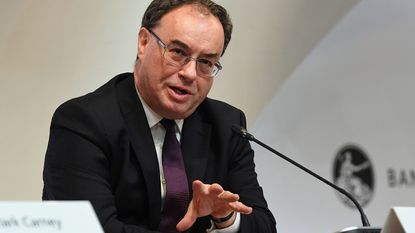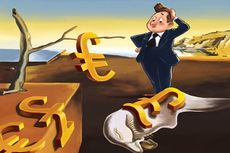Why negative interest rates are a lousy idea
The Bank of England’s governor says negative interest rates can encourage investment rather than having cash stashed in the bank. But is that really true?

The economy is relapsing, says The Observer. The Bank of England has pumped £300bn of quantitative easing into the system this year, but as the second wave of Covid-19 gathers pace all the signs are that it is not enough. UK consumer price inflation was just 0.2% in August and banks have tightened lending criteria.
That means that it’s time for negative interest rates. The Bank’s governor, Andrew Bailey, says evidence from Europe shows negative rates can encourage corporations to invest rather than just stashing cash in the bank. Right now, the economy “needs all the help it can get”. UK interest rates currently sit at 0.1%, with financial markets pricing in a shift into negative territory next year. The Bank of England is conducting preparatory work, with Bailey describing the policy as being in the “toolbox”.
The Bank would use the rate to penalise commercial banks that deposit excess reserves with the central bank, says The Times. It wants them to lend the money instead. Banks would probably avoid passing on negative rates directly to depositors and those with mortgages should not anticipate a payday. The policy would “probably be a mistake”. Lenders want their money back and in a steep downturn there are fewer creditworthy borrowers around. When the economy is weak no amount of interest-rate prodding will make the banks lend more.
Subscribe to MoneyWeek
Subscribe to MoneyWeek today and get your first six magazine issues absolutely FREE

Sign up to Money Morning
Don't miss the latest investment and personal finances news, market analysis, plus money-saving tips with our free twice-daily newsletter
Don't miss the latest investment and personal finances news, market analysis, plus money-saving tips with our free twice-daily newsletter
Negative interest rates punish the thrifty
These are bad times to be a saver, says The Economist. America’s one-year Treasury bill, a traditional way of storing cash, yields just 0.13%. “It would take more than 530 years” to double your money by reinvesting that interest. Today’s savers have three options: save less and spend more; save more to compensate for lower returns; or put their cash into riskier investments, such as shares. Central bankers generally assume that lower interest rates cause the first reaction, but the data is much less clear. As is “already happening in Japan”, the old increasingly “risk running out of money before they die”.
Negative interest rates are a “terrible idea, smacking of desperation”, says Liam Halligan in The Daily Telegraph. They are also “deeply counter-productive”. Pension funds are forced into “risky, speculative investments” in a desperate hunt for yield. The experience on the continent shows that banks avoid cutting interest rates on deposits, thus weakening their balance sheets and making the whole financial system more fragile. The winners are those with a vested interest in seeing “massively bloated” stock and bond markets surge even higher. The economy is already in a “ghastly situation”, we don’t need to make it “even worse”.
(• Listen to our podcast on negative interest rates here).
-
 British Airways revamps Avios scheme bringing down flight prices to £1
British Airways revamps Avios scheme bringing down flight prices to £1With the new Avios part-payments scheme you can now bag a British Airways flight for as little as £1
By Oojal Dhanjal Published
-
 RBS to close a fifth of branches
RBS to close a fifth of branchesRoyal Bank of Scotland plans to shut 18 branches across Scotland, resulting in the loss of 105 jobs. We have the full list of closures.
By Ruth Emery Published
-
 The MoneyWeek Podcast: Negative interest rates, armed guards and a warehouse full of cash
The MoneyWeek Podcast: Negative interest rates, armed guards and a warehouse full of cashPodcasts Merryn and John discuss the extraordinary idea of negative interest rates and explain why as far as they can see they just don't work. Plus, a genius business idea involving guarding piles of cash, and the second in our 20th anniversary questions.
By moneyweek Published
-
 What would negative interest rates mean for your money?
What would negative interest rates mean for your money?Opinion There has been much talk of the Bank of England introducing negative interest rates. John Stepek explains why they might do that, and what it would mean for your money.
By John Stepek Published
-
 Is the UK heading for negative interest rates?
Is the UK heading for negative interest rates?News The hints that negative interest rates are heading for Britain are now coming thick and fast.
By Alex Rankine Published
-
Prepare yourself for negative interest rates
Editor's letter There is a lot of talk about negative interest rates coming to the UK. They're a terrible idea, says Merryn Somerset Webb.
By Merryn Somerset Webb Published
-
Trump urges the US Federal Reserve to bring in negative interest rates
News Donald Trump has urged the Federal Reserve to embrace negative interest rates.
By moneyweek Published
-
 What are negative interest rates and could they happen here?
What are negative interest rates and could they happen here?Analysis Negative interest rates – where banks pay you to borrow money – now exist in many parts of the world. John Stepek explains why they are a terrible idea, and how likely we are to see them in the UK.
By John Stepek Published
-
The dangers of negative interest rates
Features Negative interest rates could spark the next financial crisis. And central bankers could end up the object of the public's wrath, says Merryn Somerset Webb.
By Merryn Somerset Webb Published
-
 Navigating the weird world of negative interest rates
Navigating the weird world of negative interest ratesTutorials Investors are paying good money to be allowed to lend money to governments across the world. What on earth is going on, and what does it mean for your money? John Stepek reports.
By John Stepek Published